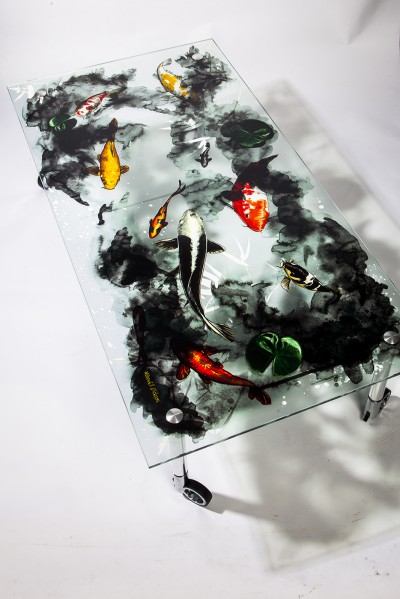
Clear inks can be used to add texture and durability to a wide-format graphic, as with this tempered glass coffee table.
Metallic ink: It sells
The number of sign shops using metallic inks in printing is growing at a fast rate, as the value and impact of metallic effects are quite strong. To be effective, after all, signs, POP displays, promotional graphics and labels all need to grab a consumer’s attention right away.
Metallic inks, more than any other specialty formulations, achieve this effect. In addition to gold, silver and bronze hues, it is possible to combine metallic silver ink with CMYK inks for a nearly unlimited number of metallic colours and pearlescent effects.
Applications
Metallic inks adhere to both coated and uncoated substrates, including PVC and PET films and photographic papers, to name a few. Calgary-based 54blue is a large-format printing shop that incorporates both metallic and white inks in window graphics for a variety of sports retailers.
Beyond the large-format arena, however, there are also mostly untapped markets for metallic inkjet printing in areas like proofing and package prototyping. In the past, packaging prototypes could only be produced on large presses that were expensive to operate. With digital inkjet technology, on the other hand, it is now possible to print a proof or prototype with metallic inks on demand with one standard device.
Metallic design proofs are also becoming more common because colour management software developers have integrated their technologies with wide-format printers. This allows PSPs to enjoy all of the benefits of metallic colour matching without having to invest in larger, costlier equipment.
Production
There are a number of technical factors to consider before adopting metallic inks. Like white inks, their particles are heavier than those in CMYK inks and require frequent circulation.
Metallic inks are also generally less scratch-resistant than CMYK, white or clear inks. To address this issue—and, for that matter, to create new colours—metallic inks are typically combined with CMYK inks, rather than printed in isolation. Lamination is also recommended to help make images last longer. It is a good idea to test the media in advance to ensure the results are as expected.
Again, many major graphic design software suites now allow for metallic colours in their files and RIP software offers colour libraries with hundreds of metallic options that can be matched and reproduced with high accuracy. Signmakers can even create their own custom colours.
Costs
Many PSPs worry about the expense of metallic inks. They do cost more than CMYK inks ounce for ounce, but less is needed to make the same visual impact. The old adage, ‘less is more,’ holds true.
Only if they are used to cover an entire background is their cost going to hurt, but that is the exception, not the rule. Metallic inks are hardly ever used as a flood. Typically, they cover just a small fraction of an overall graphic, adding pennies to its cost, not dollars. Operational costs for most applications tend to average less than 50 cents per square foot.
Meanwhile, the resulting graphics can command premium prices in the marketplace. They are often priced 30 to 40 per cent higher than CMYK-only prints.
Learn to teach
The advantages of specialty inks are highly evident. They help PSPs increase their value proposition for the customer, differentiate their business from their competitors and increase their profits per job.
As these inks are still relatively new to wide-format digital printing, however, customers may not already have graphic design files that incorporate them. Instead, signmakers will need to introduce the concept, with samples on hand to show off the benefits. And they will need to be ready to add special colours and effects to their customers’ files for them.
With this in mind, professional training is important. By participating in workshops and webinars, reading articles and documentation and watching video tutorials, signmakers can make the most of their investment and effectively sell their customers on new ideas. Training may come from the printer manufacturer, the ink supplier, support staff, dealers, other sign shops, user forums and/or industry conferences.
In the end, learning how best to exploit the initial investment in printing equipment and consumables will make all of the difference to the business. The shop and its customers will both benefit from high-impact results.
Laurie Weller is a writer and public relations (PR) representative for Roland DGA, which markets digital wide-format inkjet printers and cutters with white, clear and metallic inks. For more information, visit www.rolanddga.com.






